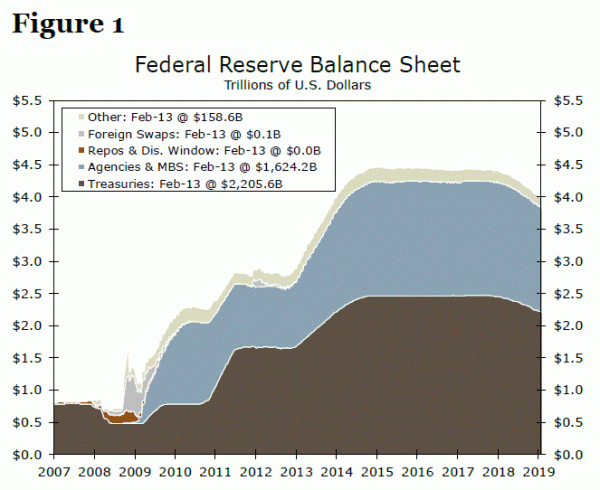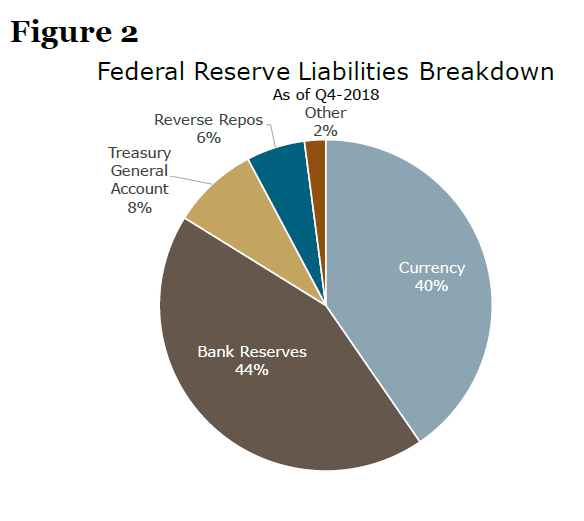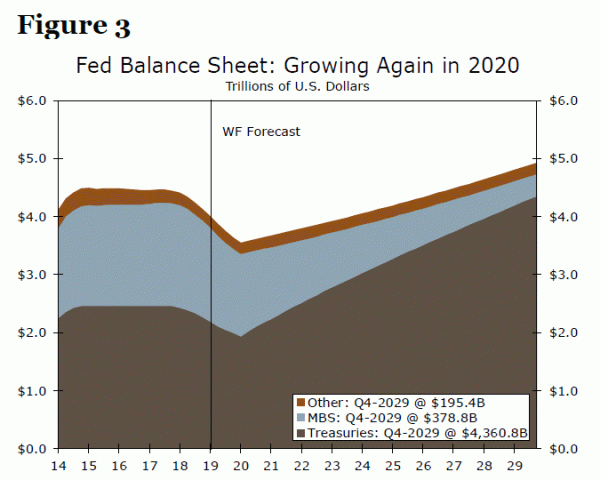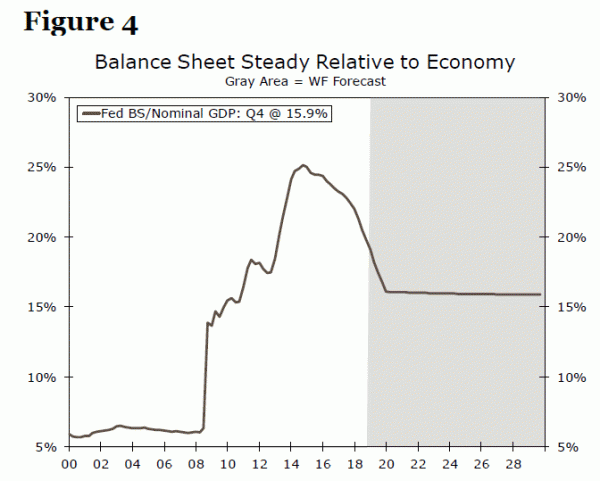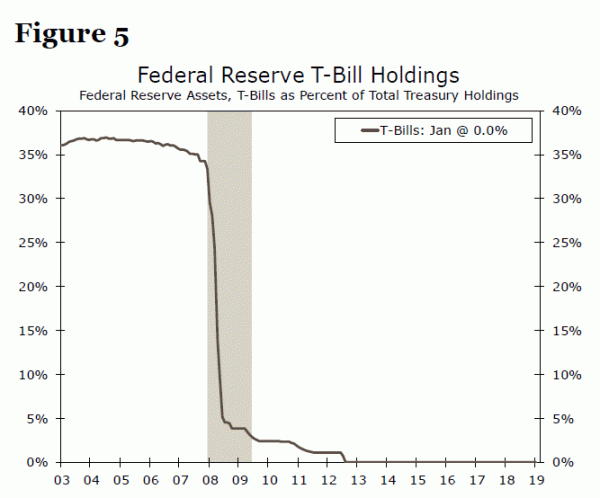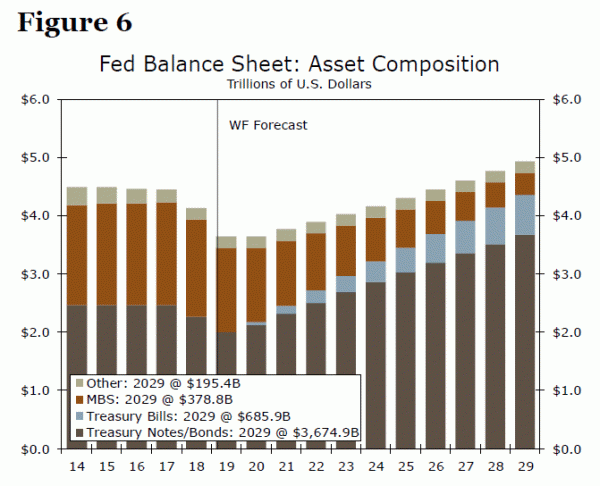Executive Summary
In a two-part report we wrote last summer, we analyzed the assets and liabilities of the Fed’s balance sheet to determine at what point it might stop reducing the size of its balance sheet.1 Our analysis found that the Fed would stop the process of “quantitative tightening” in late 2019/early 2020 when the balance sheet had receded to roughly $3.7 trillion, from a peak of $4.5 trillion in 2015. We concluded in that report that if the Federal Reserve continues to hold trillions of dollars of Treasury securities, then long-term interest rates on Treasuries likely would be a bit lower than they would be otherwise, everything else equal. We also wrote that if the Fed reverts to its pre-crisis policy of holding sizeable quantities of T-bills, then the yield curve would be a bit steeper than it would be otherwise, everything else equal.
In this report, we update our previous analysis. We confirm our earlier finding that shrinkage of the Fed’s balance sheet likely will stop at the end of 2019 at a terminal size of roughly $3.6 trillion, with about $1.1 trillion in excess reserves. We then extend our analysis by forecasting the size and composition of the Fed’s balance sheet over the next 10 years. Starting next year, we expect the balance sheet to start growing organically again, eventually reaching $5 trillion in 2029. In terms of composition, we assume that mortgage-backed securities (MBS) continue to roll off indefinitely. As a result, in the near term, we expect the Fed’s holdings of Treasuries to rise roughly $175 billion in 2020 and $280 billion in 2021, with T-bills comprising about $50 billion and $80 billion of those totals, respectively. Sizable Fed Treasury holdings and a return to the bill market likely mean lower Treasury yields and a steeper curve than would otherwise be the case.
Fed Balance Sheet to Start Growing Again in Early 2020
In early September 2008, the Fed’s balance sheet totaled about $900 billion (Figure 1). Six years later, after the Fed had bought trillions of dollars of Treasury securities and MBS via quantitative easing (QE), the balance sheet had ballooned to more than $4.5 trillion. The Fed ended its QE purchases in late 2014, although it continued to reinvest the proceeds of maturing securities until October 2017. Now that the Fed is allowing maturing Treasury securities and MBS to roll off, the balance sheet has shrunk about $500 billion from its peak.
As we discussed in our two previous reports, it is more straightforward to project the size of the Fed’s balance sheet going forward by focusing initially on liabilities. Currency in circulation and bank reserves comprise the vast majority (nearly 85%) of the Fed’s total liabilities (Figure 2). Using some assumptions about the growth of currency outstanding and bank reserves (as well as the U.S. Treasury’s cash holdings at the Fed and the outstanding amount of reverse repurchase agreements) we can generate a forecast of the liability side of the Fed’s balance sheet.2
For the next year or so, we anticipate that banks will have the capacity to let the excess reserves that they hold at the Fed continue to decline. This drop in excess reserves will allow Treasuries and MBS to continue to roll off on the asset side and reduce the aggregate size of the balance sheet. But by the start of 2020, we anticipate that the banking system will be near the lower limit of the amount of excess reserves it desires to maintain at the Fed. At that point, we expect the Fed’s balance sheet will begin to grow organically again, as is standard under “normal” circumstances. Under the assumptions we employ about currency and reserve growth, we project that this inflection point will be reached at the end of 2019, when the aggregate size of the balance sheet is roughly $3.6 trillion, with about $1.1 trillion in excess reserves. Starting next year, we expect the balance sheet to start growing again, eventually reaching about $5 trillion in 2029 (Figure 3). While this number seems quite large in dollars, relative to nominal GDP this would be down quite a bit relative to 2014, when the Fed was last purchasing securities (Figure 4).
What About the Composition of the Fed’s Holdings?
With the prospect of a growing Fed balance sheet drawing closer, an important question arises: what will the composition of the Fed’s asset holdings look like in the years ahead? There are numerous combinations and permutations the Fed could follow, and the guidance we have received from policymakers so far has been somewhat limited and qualitative in nature. That said, based off of the guidance we do have, we employ the following assumptions to build out an estimate of the Fed’s asset holdings over the next decade:
- The Fed will allow its holdings of MBS to continue to roll off indefinitely, subject to a cap of $20 billion/month.3
- The Fed will purchase Treasury securities in 2020 and beyond in proportion to the overall mix of Treasury issuance including T-bills.4
- The mix of net Treasury issuance over the next decade will be split roughly 30% T-bills and 70% notes and bonds.5
By assuming that the Fed will allow its holdings of MBS to continue to roll off indefinitely, we can then calculate the amount of Treasuries that it will need to hold to bring assets and liabilities into balance. Not only will the organic growth of the balance sheet cause the Fed’s ownership of Treasuries to rise, but the Fed will also need to buy Treasuries to replace the MBS that continue to roll off. For example, we forecast the Fed’s balance sheet will grow organically by about $120 billion over the course of 2021. However, we estimate that the Fed holdings of Treasuries will need to rise approximately $280 billion that year because we project that roughly $160 billion worth of MBS will roll off the balance sheet in 2021.
So what will happen to the composition of the Fed’s holdings of Treasuries going forward? We argued in our series last year that Fed buying of T-bills would come with several advantages, including greater flexibility in an economic downturn, less upward pressure on interest rates in repo markets and a steepening of a flat yield curve. As shown in Figure 5, T-bills accounted for onethird of the Fed’s Treasury holdings before 2008. That proportion plunged significantly during the Great Recession as a result of a variety of measures taken by the Fed to backstop the financial system. The Fed subsequently reduced its T-bill holdings to zero in 2011-2012 in an effort to flatten the yield curve via “Operation Twist.” In part because the Fed owns no T-bills at present, the weighted-average maturity (WAM) of the Fed’s portfolio of Treasuries is about 7.8 years, roughly two years longer than the WAM of the total Treasury market.
Using the assumptions laid out above, in the near term we expect the Fed’s holdings of Treasuries to rise roughly $175 billion in 2020 and $280 billion in 2021, with T-bills comprising approximately $50 billion and $80 billion of those totals, respectively (Figure 6). While this comes to a relatively modest-sounding $6 billion a month over that period, it would still amount to the Fed taking down nearly a quarter of projected net T-bill supply over the next two years. Over the longer-run, our projections gradually bring the T-bill share of the Fed’s Treasury holdings to 16% by 2029, about half the pre-crisis share, but up from 0% today.
It is worth reiterating that these forecasts rely on a variety of assumptions that could change as the Fed provides more guidance on the balance sheet. The Fed could instead, for instance, reduce the cap on monthly MBS redemptions in the years ahead, slowing the pace of MBS shrinkage and thus reducing the amount of Treasuries that must be bought in the coming years. The Fed could also announce sometime in the near future that it intends to taper its current monthly pace of Treasury/MBS redemptions. This would have the benefit of slowing the pace of decline of bank reserves on the liability side of the balance sheet, allowing the Fed to more cautiously and gradually approach the hard-to-pinpoint acceptable level of bank reserves. These represent just two of several options available to the Fed and currently under consideration. That said, even if we are wrong on a few of the particulars, it has become increasingly clear that the Fed’s Treasury holdings will start growing in the years ahead, potentially to the tune of almost $300 billion a year as soon as 2021.
From a market standpoint, we believe there are two key takeaways. First, as we discussed in our previous series, the Fed maintaining an ample supply of excess reserve/a historically large balance sheet likely means it will continue to hold a historically high proportion of Treasuries relative to the overall market. This in turn should lead to perpetually lower yields than otherwise would be the case, all else equal. Back in 2017 when the balance sheet unwind began, the Fed pegged the cumulative effect of its asset purchases and maturity extension program as having reduced the 10-year Treasury yield term premium by about 100 basis points.6 While some of this downward pressure has likely dissipated over the past couple years amid balance sheet reductions, the bulk of the remaining impact is likely to be a permanent feature of the Treasury market for years to come.
Second, if the Fed re-enters the T-bill market for the first time in a decade, it should lead to some steepening in the yield curve, all else equal. By shortening up the WAM of the Fed’s Treasury holdings, this de facto “reverse twist” could offset some of the downward pressure on the term premium that is likely to return in the face of more Fed buying of Treasury notes and bonds. Removing some T-bill supply from the market should also help alleviate some of the upward pressure on Treasury repo rates specifically, a topic we covered in a recent special report.7 While buying T-bills could help remove some of the upward pressure put on the effective fed funds rate by high repo rates, it would not surprise us if the Fed also tries to deal with this issue more holistically as it continues reviewing the process by which it utilizes administered policy rates to implement monetary policy.
1 See “Will the Fed’s Balance Sheet Ever Return to ‘Normal’?” Part I and Part II. Both reports are available upon request.
2 See Part I of our aforementioned two-part series for more details on our forecast methodology and how we define “organic” growth of the liabilities on the Fed’s balance.
3 At present, the Fed’s stated goal is to hold, in the longer run, “primarily Treasury Securities.” See the Federal Reserve’s Policy Normalization Principles and Plans, adopted effective September 16, 2014.
4 Per the December 2018 FOMC minutes: “Several participants noted that a portfolio of holdings weighted toward shorter maturities would provide greater flexibility to lengthen maturity if warranted by an economic downturn, while a couple of others noted that a portfolio with maturities that matched the outstanding Treasury market would have a more neutral effect on the market.”
5 Per guidance from the Treasury Advisory Borrowing Committee that about one-quarter to one-third of the financing gap should be met with Treasury bills. For more, see the minutes from the October 31, 2017 TBAC meeting.
6 Bonis, Brian., Ihrig, Jane, & Wei, Mei. (2017). “The Effect of the Federal Reserve’s Securities Holdings on Longer-term Interest Rates.” FEDS Notes.
7 See “Getting Technical: Managing the Fed Funds Rate.” Also available upon request.




